S.S. Catalina
1924, cut for scrap in 2009
Declared: 5/16/79
Talk about great timing. I missed visiting Monument No. 213, the S.S. Catalina, by this much. The bags were packed, the tank was full, the passport – eh, let’s face it. There’s not a chance in hell I would’ve made the 180-mile trip down to Ensenada to see and be saddened over what was left of the eighty-five-year-old “Great White Steamship”. Unfortunately, I (and you) will never get the chance now.
In 1919, five years after Doublemint’s debut, Cub-and-gum man William Wrigley Jr purchased Santa Catalina Island and the Wilmington Transportation Company from William, J.B., and Hancock Banning, sons of Phineas. To turn Catalina into the resort he envisioned, Wrigley needed a bunch of boats to ferry passengers between the mainland and the island’s city of Avalon. He had already gotten a pair of ships as part of the Wilmington Transportation Company – the Hermosa (1902) and the Cabrillo (1904). And, after World War I, Wrigley purchased from the U.S. Navy the U.S.S. Blueridge, built by the Globe Ironworks of Cleveland in 1891 and originally christened the Virginia. After a major refurbishment, this last ship was renamed the S.S. Avalon in 1920. But Wrigley wanted a fourth.
Here are pictures of the Cabrillo (courtesy of USC’s Digital Archive) and the Avalon (from the L.A. Public Library). Like the Catalina, both ships served in World War II, the Avalon staying in SoCal, the Cabrillo eventually making its way to Sacramento. The latter was left to rot and be cut for scrap near Napa. The Avalon was retired in February 1951. Nine years later, this ship, too, was cut for scrap, then suffered a fire, ultimately sinking off Palos Verdes in 1964.
William Wrigley Jr laid the keel of the million dollar S.S. Catalina at the L.A. Shipbuilding and Drydock Harbor on the day after Christmas, 1923. Just four and a half months later, on May 3, 1924, Mayor Cryer and 3,000 onlookers watched Miss Marcia Patrick, the sister of the Wilmington Steamship Company’s president, christen the ship. With A.A. Morris its captain, the Catalina left her Berth 185 homeport in Wilmington on June 30.
The S.S. Catalina stretched 301 feet long and fifty-two-feet wide. It weighed 1,766 tons. There were five decks, three of which were for passengers: the Promenade; the Saloon; and the Main. The top deck held the bridge with the pilot house and captain’s cabin.
During the Catalina’s two-hour trip to Avalon’s Steamer pier, its passengers (the ship had a capacity of 2,200) could dance to a big-band orchestra while clowns and magicians would entertain their kids. In 1929, the Cabrillo, Avalon, and Catalina, making a total of ten daily roundtrips, carried a combined half a million passengers between L.A. Harbor and Santa Catalina Island. (Wrigley sold the Hermosa in 1928.)
William Wrigley, Jr, died in 1932 and his son, Philip, inherited the company.
During World War II, the government drafted the S.S. Catalina into service, designating the ship as FS-99 for use as an Army Troop Transport. Employed in San Francisco Bay, the steamship wound up ferrying soldiers to larger warships. In her forty-four months of military service, the Catalina transported some 820,000 men, more than any other U.S. Army Transport. The ship was back to its old L.A. to Santa Catalina run on July 3, 1946.
S.S. Catalina, troops (L.A. Public Library)
At the beginning of 1948, the Wilmington Transportation Company changed its name to the Catalina Island Steamship Line. During the 1950s, there were now just single daily roundtrips made from Wilmington to Santa Catalina. In 1956 it would cost you around $6.00 for a roundtrip ticket. The Wrigleys sold the steamship line to Charles Stillwell and his M.G.R.S. Company, Inc., in 1960. Stillwell sold the Catalina – now with its terminal under the Vincent Thomas Bridge – in 1970 to Carolyn Stanalan and her family.
The S.S. Catalina completed her 9,807th and final crossing on September 14, 1975. Real estate developer Hymie Singer bought the ship for $70,000 at auction on February 16, 1977, as a belated Valentine’s Day gift for his wife, Ruth. The new owners struggled with docking fees, mooring the former ferry in San Pedro, Newport Beach, San Diego, and Santa Monica Bay, then settling the vessel off Long Beach for five years. An attempt at rehabilitation failed in 1983. Two years later, after the ship broke free of its moorings in a second instance – this time nearly causing a major accident, the Coast Guard had had enough and announced it was going to seize the Catalina. The owners opted to remove the ship from U.S. waters, and by the spring of 1985, the boat was three miles off the coast of Ensenada, Mexico. The Catalina Bar and Grill Restaurant opened on board the L.A. landmark in the summer of 1988, but didn’t stay in business long.
Over the next two decades, the S.S. Catalina, “the Great White Steamship”, slowly deteriorated, rotting, sinking, and listing, thanks to looters and thieves, the Mexican government (which had ordered the boat’s solid bronze propellers removed, allowing seawater to seep into the ship), neglect, and plain old ravages of time. Spare half a minute and watch this video of the Catalina in Ensenada, by this time a home for sea lions.
The Singers gave up ownership of the Catalina and, in 2000, the Mexican government donated the boat to the S.S. Catalina Preservation Association for non-commercial preservation purposes. Despite salvation efforts from a variety of concerned groups including the Raising the Catalina Association and the S.S. Catalina Steamship Fund, the Mexican government began cutting apart the ship for scrap just a few weeks ago.
It’s figured the S.S. Catalina alone carried 25 million people in its service of fifty-one years, maybe more than any other ocean-going ship in history. Besides being designated a city landmark in 1979, the ship was also listed on the National Register of Historic Places and declared a California State Landmark.
A very big thanks to Shawn J. Drake for his online essay, “The S.S. Catalina: the First 75 Years of a “Great White Steamer””. The shot at the top of the post is from the L.A. Department of City Planning, while the one below is from UCLA Library’s Digital Collection.
Sources:
Pool, Bob “SS Catalina is Seaworthy No More” The Los Angeles Times, Jan 6, 2009
Up next: (Site of) Mt Carmel High School Building
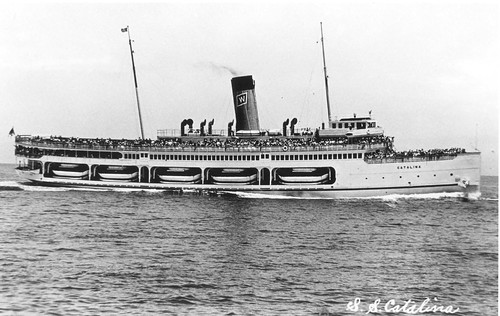

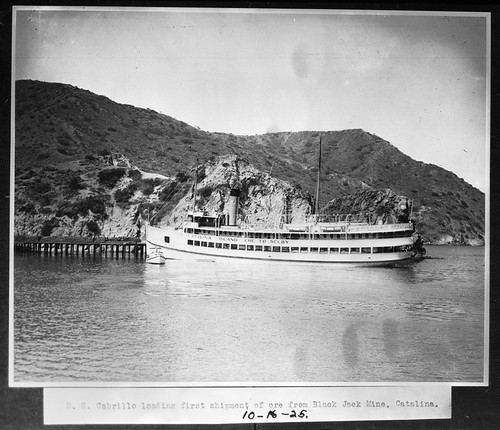
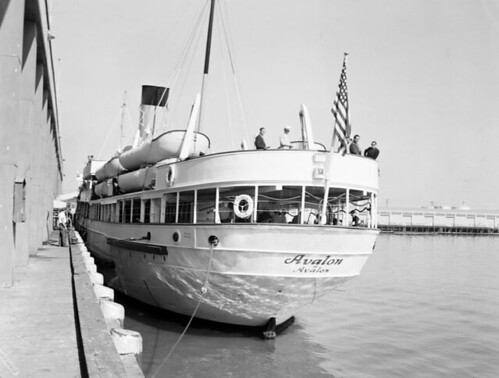
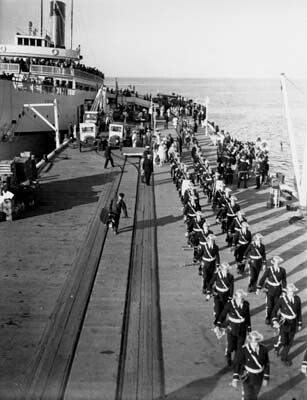
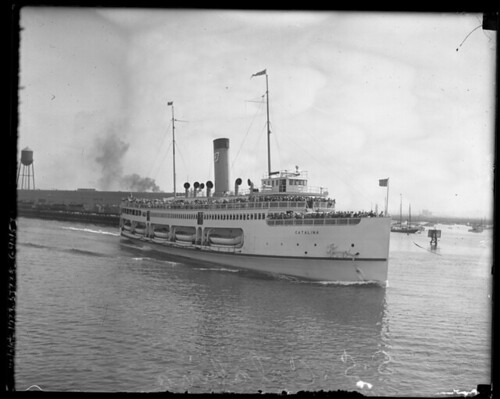

8 comments:
As a young lad in the 1950's I made several trips to Catalina aboard the S.S. Catalina. My grandfather was a professional musician who played in the dance band so I traveled free!
Hi, Greg. How big was the dance band by the 1950s?
It would be great to locate some interior shots. Really, such a sad story but now I know the origins to the name given the Hermosa hotel.
Interior shots? If you follow some of the links in the post, you'll find lots of shots of the ship throughout its history (there are a folks who were/are very passionate about the Catalina), but I don't remember seeing any of the inside, the closest being on deck.
Wow, what a great, and sad, story.
Hi Floyd, nice to see you're still around. Do you ever hear from Pickles Sorrell any more? Do you still talk "so nice and clear"? Thanks for the interesting article. Your site was referenced in a discussion of the movie "Catalina Caper" by The Satellite News, a Mystery Science Theater 3000 site.
Just found this article and had to mention my connection to S.S. Catalina. My Dad was the chief engineer for 27-28 years, Charles Beal. My brothers, sister, and I had a great time going to work with our dad Janet Beal
I just watched a "California's Gold" on tv in which Huell Howser took cameras aboard the SS Catalina in Ensenada. I don't know what year the show was filmed. The year 2010 is mentioned in the show.
It is sad to learn that groups that tried were not able to save it.
Pieces of the orignal boat were taken up to Coos Bay, Oregon and used in the house of David Engholm, who loved the boat and tried to save it. They showed a picture of David as a baby with his mother, grandmother and great grandmother on the SS Catalina. Great show.
Post a Comment